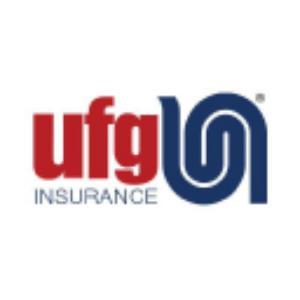United Fire Group, Inc. reports first quarter 2025 results
Rhea-AI Summary
United Fire Group (UFCS) reported strong Q1 2025 financial results with net income increasing 31% to $17.7 million ($0.67 per diluted share). Key highlights include:
The company achieved record net written premium of $335.4 million, up 4% year-over-year. Net investment income surged 44% to $23.5 million, driven by improved fixed maturity income. The combined ratio slightly increased by 0.5 points to 99.4%, while the underlying loss ratio improved by 2.9 points to 56.5%.
Core commercial renewal premiums grew 11.7%, with rates increasing 9.7%. Book value per share increased to $32.13, up $1.33 from December 2024. The company maintained its quarterly dividend tradition, paying $0.16 per share. Notable challenges included a 5% catastrophe loss ratio, with 2.6 points impact from California wildfires, and increased expenses due to a new policy administration system implementation.
Positive
- Net income increased 31% to $17.7 million
- Net investment income grew 44% to $23.5 million
- Record net written premium of $335.4 million, up 4%
- Core commercial renewal premiums increased 11.7% with rates up 9.7%
- Book value per share increased $1.33 to $32.13
- Underlying loss ratio improved 2.9 points to 56.5%
Negative
- Combined ratio increased 0.5 points to 99.4%
- Catastrophe loss ratio increased to 5.0%, impacted by California wildfires
- Underwriting expense ratio increased 3 points to 37.9% due to system development costs
Insights
UFG delivered third consecutive quarterly underwriting profit with improved underlying loss ratio and strong rate increases despite elevated expenses.
UFG's 99.4% combined ratio represents a slight deterioration of 0.5 points year-over-year but maintains the company's streak of three consecutive quarters with underwriting profits. The underlying loss ratio improved significantly by 2.9 points to 56.5%, demonstrating better core performance in the insurance portfolio.
The catastrophe loss ratio of 5.0% includes 2.6 points from California wildfires, representing a modest 0.4 point increase from the prior year. The company reported neutral prior year reserve development for the quarter. The underwriting expense ratio increased substantially by 3.0 points to 37.9%, which management attributes to costs associated with the final stages of developing a new policy administration system.
Core commercial renewal premiums increased by 11.7%, with rate increases of 9.7% exceeding loss cost trends. The company notes particular momentum in general liability and umbrella lines, with some moderation in property and automobile compared to the previous quarter. This shows disciplined pricing in a challenging environment.
The net written premium growth of 4% understates the company's true growth trajectory, as management noted that unusual ceded reinsurance premium adjustments reduced growth by 3 percentage points. The disciplined approach to pricing, stable retention, and increased new business production all point to healthy fundamentals in the insurance operations.
UFG shows strong financial improvement with 31% higher net income, 44% investment income growth, and increased book value.
UFG delivered substantial financial improvement in Q1 2025, with net income increasing 31% to $17.7 million (
The investment portfolio performed exceptionally well, with net investment income increasing 44% to $23.5 million. This remarkable growth was primarily driven by a
Book value per share increased 4.3% from year-end 2024 to $32.13, driven by net income and a decrease in unrealized investment losses on fixed maturity securities. Adjusted book value per share, which excludes the impact of unrealized investment gains/losses, increased to
The company maintained its unbroken dividend streak since 1968, with a
First quarter net income of
and adjusted operating income of
First quarter 2025 highlights compared to first quarter 2024, unless otherwise noted:(1)
- Net income increased
31% to$17.7 million . - Net investment income increased
44% to$23.5 million . - Combined ratio increased 0.5 points to
99.4% ; composed of an underlying loss ratio of56.5% , catastrophe loss ratio of5.0% , no prior year reserve development, and underwriting expense ratio of37.9% . - Underlying combined ratio increased 0.1 points to
94.4% . - Net written premium(2) increased
4% to$335.4 million . - Book value per share increased
$1.33 t o$32.13 as of March 31, 2025, compared to December 31, 2024. - Adjusted book value per share increased
$0.52 t o$34.16 as of March 31, 2025, compared to December 31, 2024.
CEDAR RAPIDS, Iowa, May 06, 2025 (GLOBE NEWSWIRE) -- United Fire Group, Inc. (UFG) (Nasdaq: UFCS) today reported financial results for the three-month period ended March 31, 2025, with net income increasing
In the first quarter, net written premium grew
Core commercial renewal premiums increased
“Overall, I am pleased with our performance in the first quarter as we delivered our third consecutive quarterly underwriting profit despite elevated industry catastrophe losses and an increased expense ratio,” said UFG President and CEO Kevin Leidwinger.
“While net written premium increased to a record of
“In addition, I am satisfied with the improvement in the underlying loss ratio resulting from earned rate achievement, lower frequency and our ongoing focus on data-informed portfolio management.
“Finally, our investment portfolio grew net investment income
“It was a promising start to the year and in the quarters ahead, we will continue to execute our strategic business plan for improved financial and operational performance throughout 2025.”
(1) Underlying loss ratio, underlying combined ratio and adjusted book value per share are non-GAAP financial measures. See Definitions of non-GAAP information and reconciliations to comparable GAAP measures for additional information.
(2) Net written premium is a performance measure reflecting the amount charged for insurance policy contracts issued and recognized on an annualized basis at the effective date of the policy. See Certain performance measures for additional information.
Consolidated financial highlights:
| Consolidated financial highlights(1) | |||||||||
| (Unaudited) | Three months ended March 31, | ||||||||
| (In thousands, except per share data) | 2025 | 2024 | Change % | ||||||
| Net earned premium | $ | 308,411 | $ | 280,859 | 9.8 | % | |||
| Net written premium | 335,376 | 321,271 | 4.4 | % | |||||
| Combined ratio: | |||||||||
| Net loss ratio | 61.5 | % | 64.0 | % | (2.5 | )% | |||
| Underwriting expense ratio | 37.9 | % | 34.9 | % | 3.0 | % | |||
| Combined ratio | 99.4 | % | 98.9 | % | 0.5 | % | |||
| Additional ratios: | |||||||||
| Net loss ratio | 61.5 | % | 64.0 | % | (2.5 | )% | |||
| Catastrophes | 5.0 | % | 4.6 | % | 0.4 | % | |||
| Reserve development | — | % | — | % | — | % | |||
| Underlying loss ratio (non-GAAP) | 56.5 | % | 59.4 | % | (2.9 | )% | |||
| Underwriting expense ratio | 37.9 | % | 34.9 | % | 3.0 | % | |||
| Underlying combined ratio (non-GAAP) | 94.4 | % | 94.3 | % | 0.1 | % | |||
| Net investment income | $ | 23,458 | $ | 16,342 | 44 | % | |||
| Net investment gains (losses) | (754 | ) | (1,202 | ) | (37 | )% | |||
| Net income (loss) | 17,700 | 13,502 | 31 | % | |||||
| Adjusted operating income (loss) | 18,296 | 14,452 | 27 | % | |||||
| Net income (loss) per diluted share | $ | 0.67 | $ | 0.52 | 29 | % | |||
| Adjusted operating income (loss) per diluted share | 0.70 | 0.56 | 25 | % | |||||
| Return on equity(2) | 8.9 | % | 7.3 | % | 1.6 | % | |||
(1) Underlying loss ratio, underlying combined ratio and adjusted operating income (loss) are non-GAAP financial measures. See Definitions of non-GAAP information and reconciliations to comparable GAAP measures for additional information.
(2) Return on equity is calculated by dividing annualized net income by average stockholders’ equity, which is calculated using a simple average of the beginning and ending balances for the period.
First quarter 2025 results:
(All comparisons vs. first quarter 2024, unless noted otherwise)
Net written premium and net earned premium increased by
The combined ratio for the first quarter of 2025 was
- The underlying loss ratio of
56.5% improved 2.9 points, reflecting overall continued favorable rate achievement and frequency trends. - Catastrophe losses added 5.0 points to the combined ratio, an increase of 0.4 points and below the five-year historical average. The California wildfires represented 2.6 points of the overall impact for the quarter.
- Prior year reserve development, excluding catastrophe losses, was neutral for the first quarter of 2025.
- The underwriting expense ratio of
37.9% increased 3.0 points mainly driven by non-recurring expenses associated with the final stages of development of a new policy administration system.
Net investment income was
| Investment results | |||||||
| (Unaudited) | Three months ended March 31, | ||||||
| (In thousands) | 2025 | 2024 | |||||
| Investment income: | |||||||
| Interest on fixed maturities | $ | 21,124 | $ | 15,160 | |||
| Dividends on equity securities | — | 341 | |||||
| Income (loss) on other long-term investments | 1,793 | (242 | ) | ||||
| Other | 3,619 | 3,898 | |||||
| Total investment income | $ | 26,536 | $ | 19,157 | |||
| Less investment expenses | 3,078 | 2,815 | |||||
| Net investment income | $ | 23,458 | $ | 16,342 | |||
| Average yields on fixed income securities pre-tax(1) | 4.34 | % | 3.57 | % | |||
(1) Fixed income securities yield excluding net unrealized investment gains/losses and expenses.
Balance sheet
| March 31, 2025 | December 31, 2024 | ||||||
| (In thousands) | (unaudited) | ||||||
| Invested assets | $ | 2,165,536 | $ | 2,093,094 | |||
| Cash | 183,678 | 200,949 | |||||
| Total assets | 3,528,264 | 3,488,469 | |||||
| Losses and loss settlement expenses | 1,816,459 | 1,796,782 | |||||
| Total liabilities | 2,710,602 | 2,706,938 | |||||
| Net unrealized investment gains (losses), after-tax | (51,702 | ) | (72,241 | ) | |||
| Total stockholders’ equity | 817,662 | 781,531 | |||||
| Book value per share | $ | 32.13 | $ | 30.80 | |||
| Adjusted book value per share(1) | 34.16 | 33.64 | |||||
(1) Adjusted book value per share is a non-GAAP financial measure. See Definitions of non-GAAP information and reconciliations to comparable GAAP measures for additional information.
The company’s book value per share was
Capital management
During the first quarter of 2025, the company declared and paid a
Earnings call access information
An earnings call will be held at 10:00 a.m. CT on Wednesday, May 7, 2025, to allow securities analysts, shareholders and other interested parties the opportunity to hear management discuss the company’s first quarter of 2025 results.
Teleconference: Dial-in information for the call is toll-free 1-844-492-3723 (international 1-412-542-4184). The event will be archived and available for digital replay through May 14, 2025. The replay access information is toll-free 1-877-344-7529 (international 1-412-317-0088); conference ID no. 3846830.
Webcast: An audio webcast of the teleconference can be accessed at the company’s investor relations page at https://ir.ufginsurance.com/event/ or https://event.choruscall.com/mediaframe/webcast.html?webcastid=7fXL6O7k. The archived audio webcast will be available for one year.
Transcript: A transcript of the teleconference will be available on the company’s website soon after the completion of the teleconference.
About UFG
Founded in 1946 as United Fire & Casualty Company, UFG, through its insurance company subsidiaries, is engaged in the business of writing property and casualty insurance. The company is licensed as a property and casualty insurer in 50 states and the District of Columbia, and is represented by approximately 1,000 independent agencies. AM Best assigns a rating of “A-” (Excellent) for members of the United Fire & Casualty Group. For more information about UFG, visit www.ufginsurance.com.
Contact:
Investor relations
Email: ir@unitedfiregroup.com
Media inquiries
Email: news@unitedfiregroup.com
Disclosure of forward-looking statements
This release may contain forward-looking statements about our operations, anticipated performance and other similar matters. The Private Securities Litigation Reform Act of 1995 provides a safe harbor under the Securities Act of 1933 and the Securities Exchange Act of 1934 for forward-looking statements. The forward-looking statements are not historical facts and involve risks and uncertainties that could cause actual results to differ from those expected and/or projected. Such forward-looking statements are based on current expectations, estimates, forecasts and projections about the company, the industry in which we operate, and beliefs and assumptions made by management. Words such as “expect(s),” “anticipate(s),” “intend(s),” “plan(s),” “believe(s),” “continue(s),” “seek(s),” “estimate(s),” “goal(s),” “remain(s) optimistic,” “target(s),” “forecast(s),” “project(s),” “predict(s),” “should,” “could,” “may,” “will,” “might,” “hope,” “can” and other words and terms of similar meaning or expression in connection with a discussion of future operations, financial performance or financial condition, are intended to identify forward-looking statements. These statements are not guarantees of future performance and involve risks, uncertainties and assumptions that are difficult to predict. Therefore, actual outcomes and results may differ materially from what is expressed in such forward-looking statements. Information concerning factors that could cause actual outcomes and results to differ materially from those expressed in the forward-looking statements is contained in Part I, Item 1A “Risk Factors” of our Annual Report on Form 10-K for the year ended December 31, 2024 (“2024 Annual Report”), filed with the Securities and Exchange Commission (“SEC”) on February 26, 2025. The risks identified in our 2024 Annual Report and in our other SEC filings are representative of the risks, uncertainties, and assumptions that could cause actual outcomes and results to differ materially from what is expressed in the forward-looking statements. Readers are cautioned not to place undue reliance on these forward-looking statements, which speak only as of the date of this release or as of the date they are made. Except as required under the federal securities laws and the rules and regulations of the SEC, we do not have any intention or obligation to update publicly any forward-looking statements, whether as a result of new information, future events, or otherwise, except as required by law. In addition, future dividend payments are within the discretion of our Board of Directors and will depend on numerous factors, including our financial condition, our capital requirements and other factors that our Board of Directors considers relevant.
Definitions of non-GAAP information and reconciliations to comparable GAAP measures
The company prepares its financial statements in conformity with generally accepted accounting principles (GAAP) in the United States of America. Management uses certain non-GAAP financial measures to evaluate its operations and profitability. Management also believes that disclosure of certain non-GAAP financial measures enhances investor understanding of our financial performance. Non-GAAP financial measures disclosed in this report include: adjusted operating income, underlying loss ratio, underlying combined ratio, and adjusted book value per share. The company has provided the following definitions and reconciliations of the non-GAAP financial measures:
Adjusted operating income: Adjusted operating income is calculated by excluding net investment gains and losses, after applicable federal and state income taxes from net income (loss). Management believes adjusted operating income is a meaningful measure for evaluating insurance company performance and a useful supplement to GAAP information because it better represents the normal, ongoing performance of our business. Investors and equity analysts who invest in and report on the insurance industry and the company generally focus on this metric in their analyses.
| Net income reconciliation | |||||||
| (Unaudited) | Three months ended March 31, | ||||||
| (In thousands) | 2025 | 2024 | |||||
| Income statement data | |||||||
| Net income (loss) | $ | 17,700 | $ | 13,502 | |||
| Less: after-tax net investment gains (losses) | (596 | ) | (950 | ) | |||
| Adjusted operating income (loss) | $ | 18,296 | $ | 14,452 | |||
| Diluted earnings per share data | |||||||
| Net income (loss) | $ | 0.67 | $ | 0.52 | |||
| Less: after-tax net investment gains (losses) | (0.03 | ) | (0.04 | ) | |||
| Adjusted operating income (loss) | $ | 0.70 | $ | 0.56 | |||
Underlying loss ratio and underlying combined ratio: Underlying loss ratio represents the net loss ratio less the impacts of catastrophes and non-catastrophe prior year reserve development. The underlying combined ratio represents the combined ratio less the impacts of catastrophes and non-catastrophe prior year reserve development. The company believes that the underlying loss ratio and underlying combined ratio are meaningful measures to understand the underlying trends in the core business in the current accident year, removing the volatility of prior year impacts and catastrophes. Management believes separate discussions on catastrophe losses and prior year reserve development are important to understanding how the company is managing catastrophe risk and identifying developments in longer-tailed business.
Prior year reserve development is the increase (unfavorable) or decrease (favorable) in incurred loss and loss adjustment expense at the valuation dates for losses which occurred in previous calendar years. This measure excludes development on catastrophe losses.
Catastrophe losses is an operational measure which utilizes the designations of the Insurance Services Office (“ISO”) and is reported with losses and loss adjustment expense amounts net of reinsurance recoverables, unless specified otherwise. In addition to ISO catastrophes, we also include as catastrophes those events, which may include U.S. or international losses, that we believe are, or will be, material to our operations, either in amount or in number of claims made. Catastrophes are not predictable and are unique in terms of timing and financial impact. While management estimates catastrophe losses as incurred, due to the inherently unique nature of catastrophe losses, the impact in a reporting period is inclusive of catastrophes that occurred in the reporting period, as well as development on catastrophes that have occurred in prior periods.
Adjusted book value per share: Adjusted book value per share is calculated by dividing shareholders' equity, excluding net unrealized investment gains and losses, net of tax, by the number of common shares outstanding. Management believes adjusted book value per share is a meaningful measure for evaluating the company's net worth that is primarily attributable to our business operations, because it removes the effect of changing prices on invested assets that can fluctuate from period to period. Book value per share is the most directly comparable GAAP measure.
| Book value per share reconciliation | |||||||
| (Unaudited) | As of | ||||||
| (In thousands) | March 31, 2025 | December 31, 2024 | |||||
| Shareholders' equity | $ | 817,662 | $ | 781,531 | |||
| Less: Net unrealized investment gains (losses), net of tax | (51,702 | ) | (72,241 | ) | |||
| Shareholders' equity, excluding net unrealized investment gains (losses), net of tax | $ | 869,364 | $ | 853,772 | |||
| Common shares outstanding (basic) | 25,447 | 25,378 | |||||
| Book value per share | $ | 32.13 | $ | 30.80 | |||
| Adjusted book value per share | 34.16 | 33.64 | |||||
Certain performance measures
The company uses the following measure to evaluate its financial performance. Management believes a discussion of this measure provides financial statement users with a better understanding of the company’s results of operations. The company has provided the following definition:
Net written premium: Net written premium is frequently used by industry analysts and other recognized reporting sources to facilitate comparisons of the performance of insurance companies. Net written premium is the amount charged for insurance policy contracts issued and recognized on an annualized basis at the effective date of the policy. Management believes net written premium is a meaningful measure for evaluating insurance company sales performance and geographical expansion efforts. Net written premium for an insurance company consists of direct premiums written and premiums assumed, less premiums ceded. Net earned premium is calculated on a pro-rata basis over the terms of the respective policies. Unearned premium reserves are established for the portion of written premium applicable to the unexpired terms of the insurance policies in force. The difference between net earned premium and net written premium is the change in unearned premium and the change in prepaid reinsurance premiums.
Supplemental tables
| Income statement | |||||||
| (Unaudited) | Three months ended March 31, | ||||||
| (In thousands) | 2025 | 2024 | |||||
| Revenues | |||||||
| Net earned premium | $ | 308,411 | $ | 280,859 | |||
| Net investment income | 23,458 | 16,342 | |||||
| Net investment gains (losses) | (754 | ) | (1,202 | ) | |||
| Total revenues | $ | 331,115 | $ | 295,999 | |||
| Benefits, losses and expenses | |||||||
| Losses and loss settlement expenses | $ | 189,696 | $ | 179,646 | |||
| Amortization of deferred policy acquisition costs | 77,354 | 65,690 | |||||
| Other underwriting expenses | 39,586 | 32,465 | |||||
| Interest expense | 2,483 | 859 | |||||
| Other non-underwriting expenses | 142 | 1,055 | |||||
| Total benefits, losses and expenses | $ | 309,261 | $ | 279,715 | |||
| Income (loss) before income taxes | $ | 21,854 | $ | 16,284 | |||
| Federal income tax expense (benefit) | 4,154 | 2,782 | |||||
| Net income (loss) | $ | 17,700 | $ | 13,502 | |||
| Net written premium by line of business | |||||
| (Unaudited) | Three months ended March 31, | ||||
| (In thousands) | 2025 | 2024 | |||
| Net written premium(1) | |||||
| Commercial lines: | |||||
| Other liability(2) | $ | 99,352 | $ | 89,862 | |
| Fire and allied lines(3) | 64,955 | 70,653 | |||
| Automobile | 78,930 | 74,841 | |||
| Workers’ compensation | 18,989 | 17,080 | |||
| Surety(4) | 16,111 | 14,858 | |||
| Miscellaneous | 3,455 | 2,130 | |||
| Total commercial lines | $ | 281,792 | $ | 269,424 | |
| Personal lines: | |||||
| Fire and allied lines(5) | $ | 1,285 | $ | 4,876 | |
| Automobile | 418 | — | |||
| Miscellaneous | — | 2 | |||
| Total personal lines | $ | 1,703 | $ | 4,878 | |
| Assumed reinsurance(6) | 51,881 | 46,969 | |||
| Total | $ | 335,376 | $ | 321,271 | |
(1) Net written premium is a performance measure reflecting the amount charged for insurance policy contracts issued and recognized on an annualized basis at the effective date of the policy. See certain performance measures for additional information.
(2) Commercial lines “Other liability” is business insurance covering bodily injury and property damage arising from general business operations, accidents on the insured’s premises and products manufactured or sold.
(3) Commercial lines “Fire and allied lines” includes fire, allied lines, commercial multiple peril and inland marine.
(4) Commercial lines “Surety” previously referred to as “Fidelity and surety.”
(5) Personal lines “Fire and allied lines” includes fire, allied lines, homeowners and inland marine.
(6) Assumed reinsurance includes Funds at Lloyd's
| Net earned premium, net losses and loss settlement expenses and net loss ratio by line of business | |||||||||||||||||||
| Three months ended March 31, | 2025 | 2024 | |||||||||||||||||
| Net losses | Net losses | ||||||||||||||||||
| and loss | and loss | ||||||||||||||||||
| Net | settlement | Net | Net | settlement | Net | ||||||||||||||
| (In thousands, except ratios) | earned | expenses | loss | earned | expenses | loss | |||||||||||||
| (Unaudited) | premium | incurred | ratio | premium | incurred | ratio | |||||||||||||
| Commercial lines | |||||||||||||||||||
| Other liability | $ | 89,139 | $ | 60,243 | 67.6 | % | $ | 80,397 | $ | 62,022 | 77.1 | % | |||||||
| Fire and allied lines | 62,420 | 32,020 | 51.3 | 62,410 | 35,620 | 57.1 | |||||||||||||
| Automobile | 64,355 | 42,801 | 66.5 | 56,509 | 42,938 | 76.0 | |||||||||||||
| Workers’ compensation | 14,157 | 9,757 | 68.9 | 12,427 | 6,218 | 50.0 | |||||||||||||
| Surety | 15,731 | 4,375 | 27.8 | 14,904 | 3,558 | 23.9 | |||||||||||||
| Miscellaneous | 3,420 | 2,060 | 60.2 | 1,567 | 842 | 53.7 | |||||||||||||
| Total commercial lines | $ | 249,222 | $ | 151,256 | 60.7 | % | $ | 228,214 | $ | 151,198 | 66.3 | % | |||||||
| Personal lines | |||||||||||||||||||
| Fire and allied lines | $ | 1,260 | $ | 769 | 61.0 | % | $ | 4,895 | $ | 3,734 | 76.3 | % | |||||||
| Automobile | 796 | 508 | 63.8 | % | — | (9 | ) | NM | |||||||||||
| Miscellaneous | 1 | (33 | ) | NM | 3 | (38 | ) | NM | |||||||||||
| Total personal lines | $ | 2,057 | $ | 1,244 | 60.5 | % | $ | 4,898 | $ | 3,687 | 75.3 | % | |||||||
| Assumed reinsurance | 57,132 | 37,196 | 65.1 | 47,747 | 24,761 | 51.9 | |||||||||||||
| Total | $ | 308,411 | $ | 189,696 | 61.5 | % | $ | 280,859 | $ | 179,646 | 64.0 | % | |||||||
NM = Not meaningful







